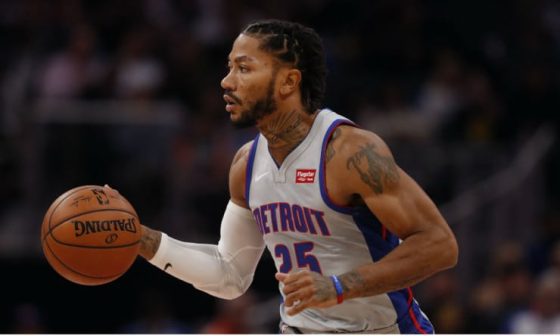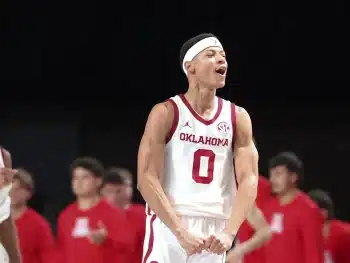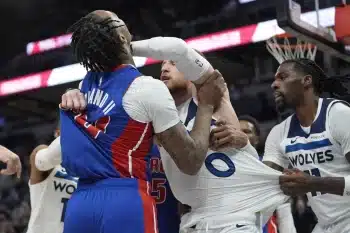NBA
Derrick Rose’s New Basketball Life Is Exciting

Between being named Rookie of the Year in 2008-09 and becoming the youngest MVP in history two years later, Derrick Rose enjoyed a fast start to his career. But since his infamous ACL-tear in 2012, Rose has suffered through inconsistent play, nagging injuries, and abbreviated seasons.
Now, Rose has found a new home in Detroit – and with it, perhaps a new basketball life.
Rose had a mini-revival in Minnesota last year. He averaged 18 points and 4.3 assists in only 27.3 minutes per game. He did this with a true shooting percentage of 55.7, the highest of his career. Although he played another shortened season, appearing in only 51 games, that number is the highest it’s been since he played in 64 games for the Knicks in 2016-17. The highlight of Rose’s Timberwolves tenure came on Halloween when he scored a career-high 50 points in a win over Utah. The 50-point night was the first time Rose had scored over 40 in seven years.
He took the momentum from that early-season game and turned it into a solid season. Now, he looks poised to carry that momentum to his new home in Detroit.
Rose has come out scorching, scoring 76 points on 31-48 shooting from the field. He’s done this having not played over 27 minutes per game and having only made one two-pointer. It’s been a throwback start for Rose, with the bulk of his damage being done at the rim and in the mid-range. While he lacks the bounce he displayed pre-knee injury, he’s still dangerous going downhill – his first points of the season came on a semi-transition layup, where he used a left-to-right crossover to blow by Malcolm Brogdon.
Of course, the surprise would seem to be how well and how efficiently he’s scored. But, what may be more surprising is how sustainable his play looks – not in volume, but quality.
Dwane Casey has been adamant so far that he’s not going to increase Rose’s playing time, even in light of his play.
“I’m not going to ruin a guy’s comeback by getting excited and playing him 30 minutes and losing him for two or three games,” Casey said after Detroit’s loss to Philadelphia on Saturday. “We’re going to be disciplined.”
Casey notes that that may be frustrating for fans, but it should bode well for both Rose and the Pistons in the long-term. Limiting Rose’s playing time keeps him fresh, and the 30-minute-threshold has proven to be the magic number with him as of late.
In Minnesota last year, Rose’s minutes fluctuated wildly. He played right at 30 through the first eight games, culminating with 40 minutes on his 50-point game. In the following game on Nov. 2, he was only able to play four minutes before being forced from action. He missed the next game on Nov. 5, and played about 36 minutes per over the next four. He was out for the fifth game of that stretch.
This was a trend for Rose; a string of higher-minute games led to absences or extremely reduced minutes in the games immediately after. From Dec. 26 to the end of the season, Rose only played in 21 games.
Restricting his minutes is crucial. And that’s because of another surprise: Derrick Rose is crucial to a playoff-hopeful Detroit’s postseason chances! Rose hasn’t been a central piece to a playoff team since the 2014-15 Chicago Bulls. He is that now, regardless of whether he starts or comes off the bench. Coming off a first-round sweep at the hands of Milwaukee last year, Detroit is again a fringe playoff team, destined to vie for the final spot. Outside of Blake Griffin and Andre Drummond, no one is more vital to the Pistons’ success.
It’s not a stretch to say Rose is better than Reggie Jackson. Per Cleaning the Glass, Rose shot 62 percent at the rim last season. Jackson shot 53 percent, one of the worst marks in the league. They both shot 43 percent from mid-range. From three, where Jackson would figure to have an advantage, Rose was 39 percent to Jackson’s 38. Granted, Rose took 300 fewer attempts than Jackson. But as Blake Griffin continues to increase his three-point volume and Luke Kennard emerges into a full-time player, less threes from Jackson and Rose may not be a bad thing.
Speaking of Kennard: through three contests, Rose has shown solid chemistry with the former Blue Devil. The two mesh together well; Kennard spaces the floor for Rose, and Rose’s speed attacking the rim is a natural complement to Kennard’s growing ability to function as the second-side ballhandler. They could develop into a (very) poor man’s version of Donovan Mitchell and Joe Ingles in the East. It’s all too perfect that Ingles and Kennard are both lefties.
Rose also fits next to Andre Drummond. As Rose is a throwback point guard, the new pick and roll pair is a throwback as well. Drummond is not going to pop, and Rose is not looking to shoot threes when defenders go under. Instead, Rose uses that space as a loading zone to get moving; Drummond, meanwhile, takes his massive frame and dives hard to the rim. Whether or not this old-school style works over a full season remains to be seen; for now, it’s intriguing at the least.
Blake Griffin’s return will cover some of Detroit’s current holes. In the meantime, Rose looks poised to continue shining as the team’s primary shot creator. This is a welcome challenge, and the reason he chose to sign with the Pistons this offseason. A new start looks to be exactly what Rose needed, but it’s still surprising to see him do it so effectively to begin the year.
After a career marred with injury and filled with what-ifs, surprising may not even be the right word; maybe it’s just plain exciting.











